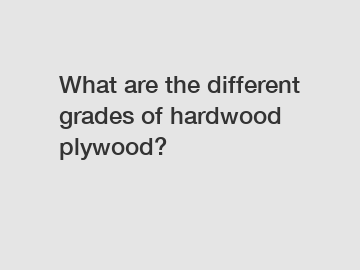What are the different grades of hardwood plywood?
When it comes to woodworking and interior design, the quality, durability, and aesthetic appeal of hardwood plywood play a crucial role. However, not all hardwood plywood is created equal. In fact, there are various grades available, each possessing its own unique characteristics and suitability for different applications. In this blog, we will delve into the world of hardwood plywood grades, providing you with a comprehensive understanding of their differences and how to choose the right one for your project.
1. Select Grade:
Starting at the top, we have Select Grade hardwood plywood. This grade offers exceptional appearance and consistency, making it ideal for premium projects where the natural beauty of the wood is paramount. Select Grade plywood is carefully selected and features minimal blemishes, ensuring a polished and uniform surface. This grade is often used in high-end furniture, cabinetry, and architectural applications.

2. A Grade:
Next in line is the A Grade hardwood plywood, which is a step below the Select Grade. A Grade plywood showcases a smooth and even veneer with only limited color variation, highlighting the natural beauty of the wood. While it may have slightly more noticeable blemishes compared to Select Grade, A Grade hardwood plywood is still of excellent quality and finds applications in furniture, cabinetry, and architectural installations where appearance matters.
3. B Grade:
Moving down the hierarchy, we come across B Grade hardwood plywood. This grade features a more natural and rustic look, lending character to any project it is used in. B Grade plywood may contain more color variation and minor defects, such as visible knots and patches. It is an excellent choice for applications where a more relaxed and charming appearance is desired, including rustic furniture, wall paneling, and flooring.
4. C Grade:
C Grade hardwood plywood steps further into the realm of unique aesthetics. This grade allows for more variability in color, grain patterns, and noticeable blemishes. While some might consider these imperfections as flaws, others perceive them as distinct features, adding character and personality to a project. C Grade plywood is commonly used for shelving, crates, and other industrial applications that prioritize functionality over appearance.
5. D Grade:
At the bottom of the grading scale, we find D Grade hardwood plywood. This grade is highly practical and typically reserved for projects where functionality takes precedence over visual appeal. With its various surface defects, knots, and patches, D Grade plywood may require additional finishing or veneer to achieve a more acceptable appearance. It is often utilized for temporary structures, construction sites, packaging materials, and other applications where plywood's structural properties are the primary focus.
Additional resources:Ultimate Guide: Unveiling the Best Pipe Wrapping Tape
Customize Monuments: Preserving History or Erasing Heritage?
Which PVC Garage Baseboard Style Will Rule?
Should flashing tape be primed before applying?
Ultimate Guide to OEM Ball Valves: All Your Questions Answered
Are Slotted Rail Terminal Energy Absorption Systems suitable for all types of roads?
Heart-Shaped Angel Tombstones: Captivating Hand Carved Designs Unveiled!
Choosing the Right Grade:
Now that we've explored the different grades of hardwood plywood, you might be wondering how to select the appropriate one for your project. Several factors come into play while making this decision:
1. Project Requirements:
First and foremost, consider the specific requirements of your project. If you are creating a premium piece of furniture, Select or A Grade plywood will ensure a polished result. On the other hand, for a more rustic or industrial project, B, C, or even D Grade plywood might be a better fit.
2. Appearance vs. Functionality:
Evaluate the desired balance between appearance and functionality. For projects where aesthetics are essential, higher grades will provide a more refined finish. However, if structural integrity is the top priority, grades lower on the scale may be more suitable.
3. Budget Constraints:
As expected, higher grades of hardwood plywood tend to come with a higher price tag. Assess your budget and weigh the importance of appearance against cost. In some instances, a lower grade plywood with the right finishing techniques can achieve a satisfactory result while keeping expenses in check.
Conclusion:
Understanding the different grades of hardwood plywood allows you to make informed decisions when selecting materials for your woodworking projects. Each grade brings its own unique qualities, ranging from impeccable aesthetics to unrivaled functionality. By considering the specific requirements, appearance-to-functionality ratio, and budget limitations, you can confidently choose the grade that best aligns with your project goals. So, whether you aspire to create an elegant piece of furniture or a structurally sound installation, the world of hardwood plywood grades has something to offer for every creative endeavor.
The company is the world’s best Marine Plywood for Sale, film face plywood, make shelves out of plywood supplier. We are your one-stop shop for all needs. Our staff are highly-specialized and will help you find the product you need.
Additional resources:Why use aluminum for air conditioner coils?
Which Rooms in Your Home Deserve Black LVT Flooring for a Dramatic Transformation?
How do I choose a geotextile?
FHWA-NHI-05-039: Your Ultimate Guide to Road Safety
Which Hardwood Plywood is Worth the Hype?
Which Anti-Corrosive Primer Is Truly Revolutionary?
Should I opt for post tensioning systems with threaded rebar in my B2B construction purchase?
Related Articles









Comments
0